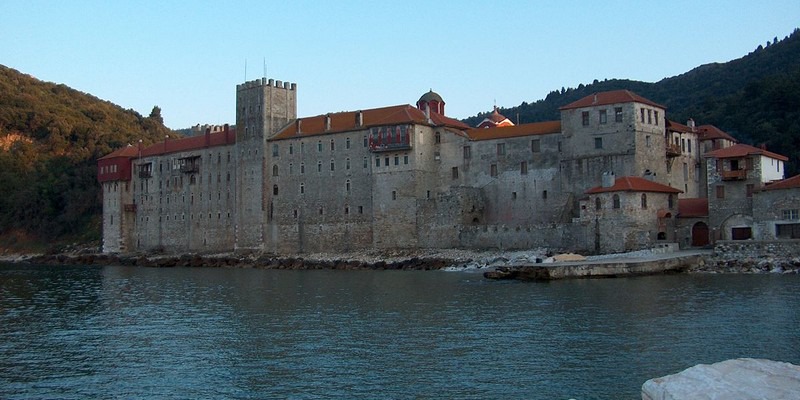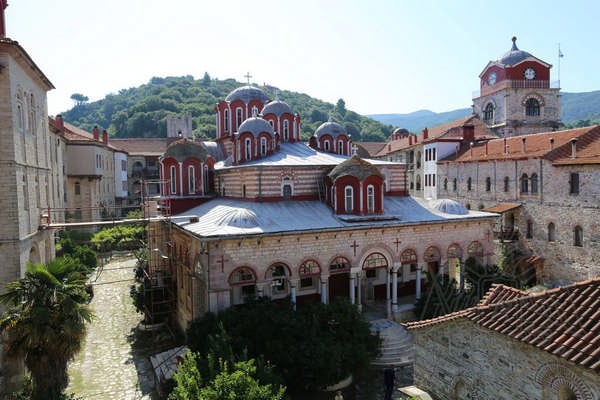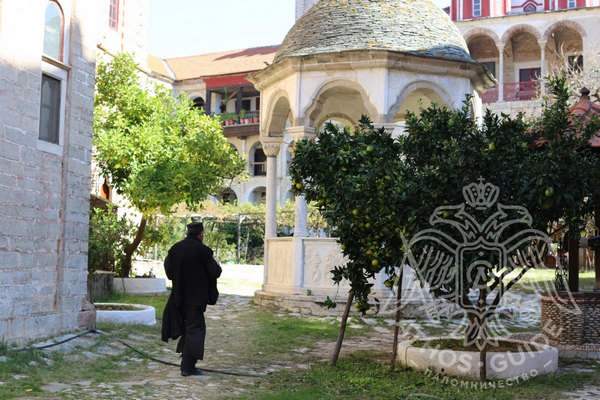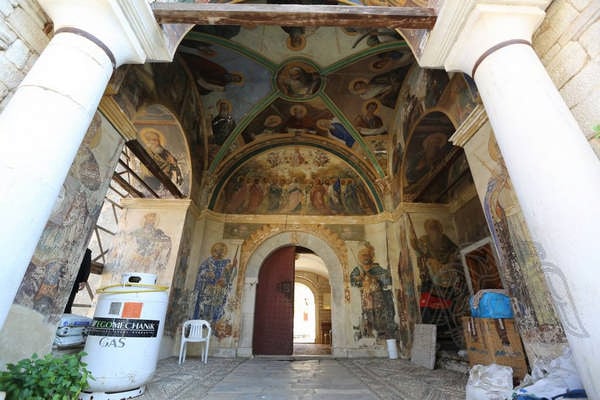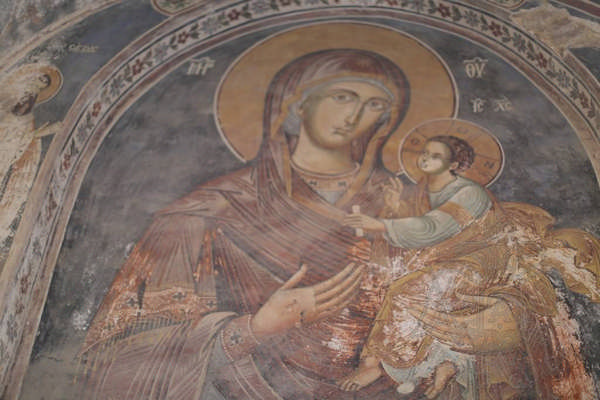History and present days
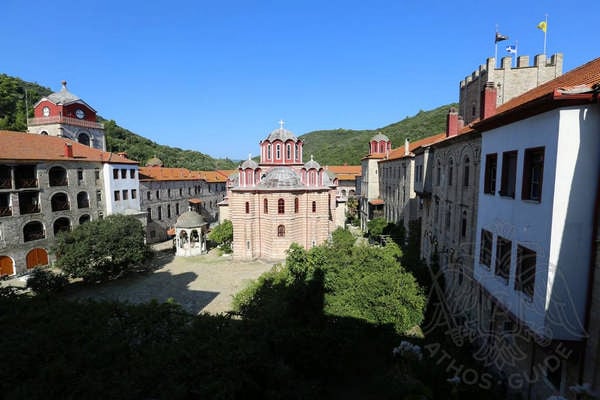
The Monastery of Esphigmenou is built on the northeast coast. Its foundations are literally washed by the waves. Its building complex occupies the entire narrow lowland area formed between three hills: the one of the Life-giving Spring(east), the one of Gribovitsa (south) and the one of Samaria (west). The floor plan has a quadrilateral shape. The wings are four-storey high. The sea-facing façade lacks balconies and cloisters for security reasons. The narrow windows resemble battlements, which gives an unexpected austerity and introspection to the monastic complex.
The fortified view of the monastery is emphasized by the defensive towers built into the north wing. The horizontal dimension of the monastery is interrupted by them, as well as by the bell tower (south wing). The roofs of all the wings are covered with tiles. Many chapel domes project onto the roofs. The monastery has a great number of towers that are projected above the fortified courtyard. Some of the older ones have no roof at all. The newer towers date from the mid-19th century, when the monastery was extended to the east. The seaside tower is remarkable for its size and bears a double row of catacombs.
History
According to tradition, the monastery dates back to the 5th century, while the emperor Theodosios II and his sister Pulcheria are considered to be its founders. The original monastery is claimed to have been located half a kilometre west of the present monastery but was destroyed by a precipitation of rocks. The earliest historical evidence of the monastery dates back to the end of the 10th - beginning of the 11th century. References are found in a letter of Saint Paul of Xeropotamou (1016), in the testament of the monk Demetrios of the small monastery of Chalkeos (1030) and in the Typikon of Constantine Monomachos (1046), where the monastery appears to occupy the fifth place in the hierarchy of the Athonite monasteries of that time. There is also a document in the Monastery of Vatopaidi (998) which testifies the existence of the monastery by the name “Esphagmenou” (means the one who is slaughtered). This is perhaps the most likely origin of the name of the monastery, which other scholars attribute to the narrow space between the hills (therefore “Esphigmenou”, which means the one who is constricted) or to a monk who was held tight by his monastic belt.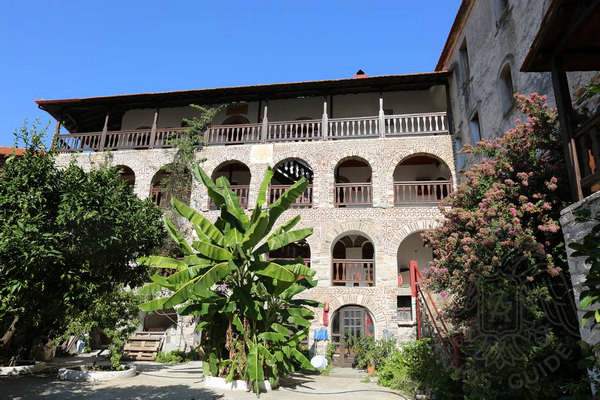
The monastery flourished in the period from the second half of the 13th to the first half of the 16th century. The Emperor John V Palaiologos, the Serbian Kralj Stefan Dusan and the Serbian ruler Brankovic contributed to the prosperity with important donations and sponsorships. At that time, there used to live there the later Ecumenical Patriarch Athanasios, who took on the difficult task of putting everything in the orthodox Church into order after the Latin Patriarch Vekko, and Saint Gregory Palamas, who was a great figure of the Hesychasm and Archbishop of Thessaloniki. Because of its location, the monastery was repeatedly plundered by pirates. It was also damaged by fires during the 14th century and burned by the Ottomans in 1533. These disasters led to its desolation. The neighbouring monasteries of Hilandar and Zografou encroached on its property, leading to long-running legal actions and disagreements regarding its territory. In the mid-17th century the monastery managed to be reconstructed and rebuilt thanks to the donations from Russia and the Danubian principalities.
In 1746 the Esphigmenou Monastery sold to the Monastery of Zografou the arsanas of Jovanitsa, which had been under its possession since 1528. During the 18th century the monastery was helped by generous donations of the Metropolitan Gregory of Melenikos, who after his leaving from the throne became a monk there, such as the monk Gerasimos and the Metropolitan Daniel of Thessaloniki, who restored the monastery to the cenobitic system. Its conversion was recognized by a sigil of the Patriarch Gregory V (1797), who also contributed to its reconstruction. The contribution of a series of abbots (Akakios, Efthimios, Theodoritos, Agathaggelos), to whom all the present building facilities are attributed, was of great importance. Agathangelos' successor was Luke. During his time, a school of hagiography was established in the monastery. In 1821 Emmanuel Pappas declared the Revolution and the monastic community suffered a great destruction by the Ottoman occupation forces.
For nearly thirty years, the monastery has been in the center of current affairs. The banners with the slogan "Orthodoxy or Death", prominently displayed, mark the opposition of a group of monks to the 1964 meeting in Istanbul between the Ecumenical Patriarch Athenagoras I and Pope Paul VI of Rome, which led to a mutual lifting of the anathemas between the Orthodox and the Roman Catholic Church. Since then, a group of monks has refused to mention the name of the Ecumenical Patriarch in the Divine liturgy and all services, abstains from the administrative institutions of the Athonite state and does not recognize the validity of their decisions. 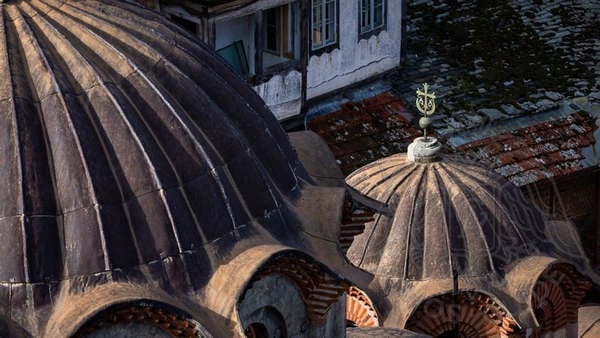 In this stance, they have taken by their site the Old Testament Christians (who like to be called as "Genuine Orthodox Christians"), as well as the anti-patriarchal circles in the United States. In early 2003, the Ecumenical Patriarchate declared that this group of the monks of the Esphigmenou Monastery are "irredeemably schismatic" and it took off all relevant procedures provided by the constitutional charter of Mount Athos and the Constitution of Greece for their removal. The Patriarchate, as well as the Holy Community stated that they did not wish to use any force of violence. The monks of the Ephigmenou Monastery appealed to the Council of State. In the words of the Athonite monks, the case "will take time".
In this stance, they have taken by their site the Old Testament Christians (who like to be called as "Genuine Orthodox Christians"), as well as the anti-patriarchal circles in the United States. In early 2003, the Ecumenical Patriarchate declared that this group of the monks of the Esphigmenou Monastery are "irredeemably schismatic" and it took off all relevant procedures provided by the constitutional charter of Mount Athos and the Constitution of Greece for their removal. The Patriarchate, as well as the Holy Community stated that they did not wish to use any force of violence. The monks of the Ephigmenou Monastery appealed to the Council of State. In the words of the Athonite monks, the case "will take time".
In the Esphigmenou Monastery, apart from Patriarch Athanasios and the Archbishop of Thessaloniki Gregory Palamas (who served as its abbot for three years), great personalities such as Akakios, Anthimos, Agathaggelos, Luke and Sophronios also used to live there. Among others, Saint Anthony Pechersky became a monk in the Monastery of Esphigmenou. In a cave, on the hill of Samaria, Saint Damian the Esphigmenite practised his monastic rules and exercised in prayer. The new martyrs Euthymios from the skete of Iviron († 1814, Constantinople), Agathaggelos († 1819, Smyrna), who was responsible for the trapeza of the monastery, Timotheos († 1820, Adrianople), as well as the great preacher Germanos, they all lived and died in the Monastery of Esphigmennou. Gerasimos Smyrnakis served as abbot and also died there.
Gerasimos Smyrnakis (Nafplio 1862 - Patmos 1935)
Gerasimos Smyrnakis was a cavalry officer, who abandoned his military career and became a monk before 1888. He was ordained an hieromonk and served as abbot of the Monastery of Esphigmenou (1906-1908). His voluminous work Mount Athos (1903) completes a series of works that go beyond pilgrimage guides to individual monasteries and seek a comprehensive view of the Athonite monasticism. The work is accompanied by a map compiled by him and constitutes a landmark, an endless source of information and knowledge about the Athonite tradition, as well as a detailed record of the pan-Slavist ambitions and intrigues that had grown at this time in Athos.
